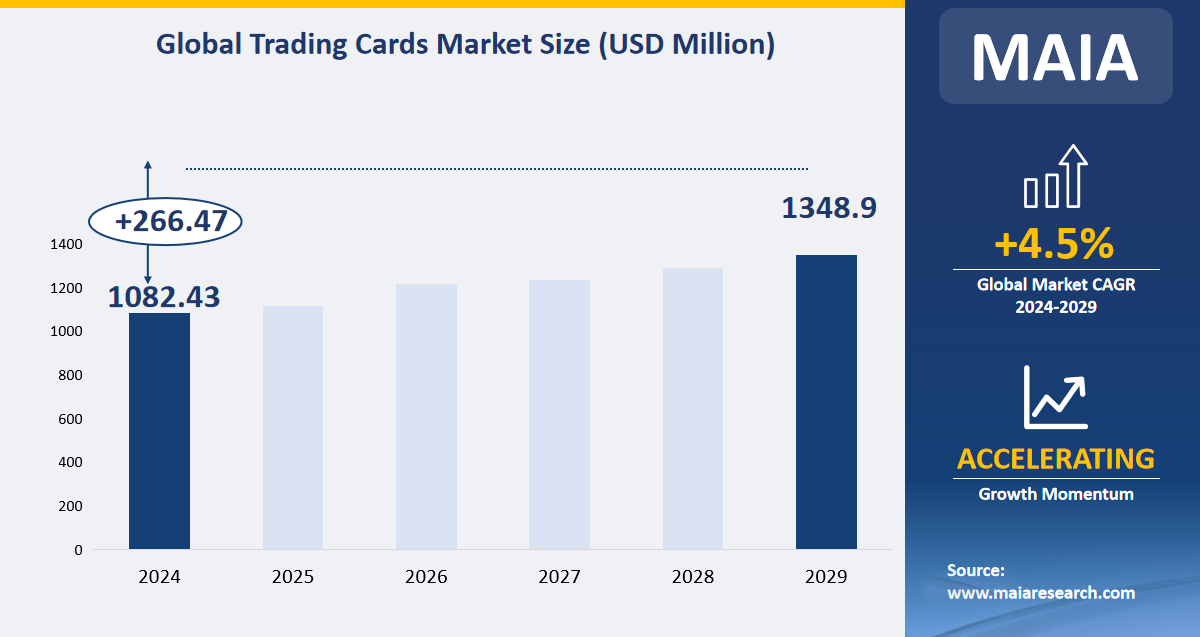The global trading cards market size will be $1082.43 million in 2024 with a CAGR of 4.5% from 2024 to 2029.

Definition
Trading card is a small card, usually made out of paperboard or thick paper, which usually contains an image of a certain person, place or thing (fictional or real) and a short description of the picture, along with other text (attacks, statistics, or trivia). There is a wide variation of different types of cards.
Market by Type
Based on type, the trading cards market is divided into sports cards and non-sports cards. Among them, sports cards occupy a major share of the global trading card market.
Sports cards are a general term for trading cards with sports-related topics, as opposed to non-sports trading cards that handle other topics. Sports Cards are trading cards related to various sports, including football cards, baseball cards, basketball cards, boxing cards, and so on. Trading cards related to animation and games are usually non-sport cards, which are distinguished from sports cards. Non-sports trading cards usually feature games, cartoons, comic characters, TV series, movie stills, and so on.
Market by Application
Based on application, the trading cards market is divided into physical education, game and anime. Among them, due to the booming sports market, physical education trading cards have the largest market. Physical education cards include most major sports, especially those played in North America, including but not limited to American Football, Football Association (football), baseball, basketball, boxing, golf, ice hockey, racing, and tennis.
Market Trends
‘The number of people collecting trading cards has steadily increased, providing important opportunities for trading cards appreciation’
Trading cards are a more secure form of sports betting, and sports betting are gradually being legalized in the United States. With it came a new wave of sports betting, but it was really hard to rely on sports betting to make money. At present, there are not so many people paying attention to sports trading cards. For savvy investors, this means many opportunities. When former collectors rediscover the field, they will return to this hobby. In the past few years, the number of people collecting trading cards has been steadily increasing, and this situation will accelerate in the next few years. More people mean more demand, and it means prices will rise. Due to the popularity of games and cartoons, the characters in them are also popular with consumers, which will also promote the development of the market to a certain extent. In addition, as per capita disposable income continues to increase, the number of trading cards collected in the coming years is expected.
‘The liquid market provides development opportunities for trading cards’
The development of the trading card market is mainly driven by consumer preferences. Some people collect it purely for joy and hobby. They collect the entire game, their favorite player or their favorite team. Others are purely guessing the card’s monetary value potential and how best to sell 2015-2027 Global Trading Cards Industry Market Research Report, Segment by Player, Type, Application, Marketing Channel, and Region 9 its card. Others do both at the same time. They like to collect and hold some cards and move other cards that they don’t want, so they can make money from it. Old-fashioned trading cards (commonly considered pre-1980 products) are highly collectible because their production is very limited. In the 1980s and 1990s, there was a strong interest in trading cards, which led to a demand for mass production, which in turn caused the value of most distributions to plummet. Today, card issuers consider it important to limit product production and adopt more responsible manufacturing methods to increase the value of trading cards. Today, the most valuable cards are usually related to the rookie year of the athlete, and / or come from super premium versions such as the Exquisite Collection, The Cup and Ultimate Collection.
With the continuous development of the economy, the trading card transactions are going digital, and collectors can trade at any time and obtain instant prices. For example, selling trading cards through eBay, COMC, and other online platforms and auction houses is actually easy. For those who want to invest in the trading cards, they can now invest money and wait for the price to rise before selling and cashing out to enjoy profits. With trading card transactions tend to digital platform (which brings together collectors around the world), this will drive the development of the trading card market.
Market Drivers
‘Signature cards increase the scarcity of cards, which will drive up the value of trading cards’
Although vintage cards are indeed a scarce commodity, modern manufacturers can also artificially increase the value of their products to make them scarce. This can be done by including parallel sets of serial numbers, cards with game wear memorabilia, autographs, etc. Signing adds value to most cards. For example, collectors like to chase the key signature cards in the new series. For investors, collecting signature cards can also ensure a certain degree of scarcity and future appreciation. Because star players, especially superstars, have a limited number of signatures each year, signature cards are always rare. When card companies are unable to obtain enough signatures to meet market demand, they expand product capacity. This means that there will be fewer signature cards per series and a lower chance of get a signature from each box. If you are buying a signature card on the secondary market, this will not affect you. But if you are unpacking or unpacking to search for signatures, you need to unpack more cards and it is difficult to unpack. Therefore, as signature cards increase the scarcity of cards, the value of trading cards will increase.
‘Card issuers build scarcity for their products, which will drive market growth’
The reason why trading cards in the late 80’s and early 90’s was of low value was because card companies were issuing cards wildly. During this period, corresponding to the increase in card demand is the increase in card issuance. Due to the high profits of the industry, the entry of new card issuers and the increase in card issuance, the industry is saturated and competition is fierce. However, when card issuance increased to absurd levels but demand began to weaken, the trading card market entered a recession. Today, major market players are avoiding this situation, especially in high-end card series. The introduction of numbered cards established the scarcity of cards and restricted their circulation. Scarcity is the key to rising prices for any form of investment. For series like National Treasures, Flawless and Immaculate, each card is numbered. Although its price is very expensive, it is in short supply and will add value to some of the key cards in the series.
Top Companies
The Trading Cards market is highly competitive with major players including Panini, Topps, Upper Deck, Rittenhouse, Leaf, Futera, TRISTAR, SAGE, and Cryptozoic.
Market Scope
Coverage | Detail |
Market Size in 2024 | 1082.43 million USD |
Market Size in 2029 | 1348.90 million USD |
CAGR from 2024-2029 | 4.5% |
Competitive Landscape |
|
Market Segment by Type | Sports Cards Non-sports Cards |
Market Segment by Application | Physical Education Game Anime Other |




